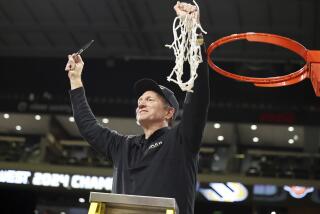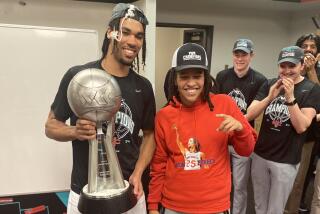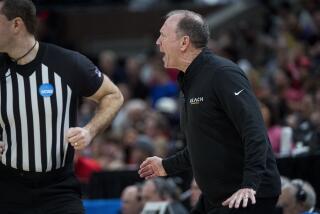Morrison Takes Charge With Even-Handed Approach
- Share via
Keith Morrison learned about versatility at an early age. As an infant, when he reached out with his left hand for a baby bottle, his mother refused to give it to him.
“I didn’t want him to be left-handed,” his mother, Dorothy Johnson, explained. “I wasn’t left-handed, his sister wasn’t left-handed and his father wasn’t left-handed.”
So, before he left his crib, Morrison learned to use his right hand.
The result, 21 years later, is a crafty point guard for Washington State who says he doesn’t favor either hand. The 6-3 senior shoots free throws with his right hand, but when he was a two-time All-City player at Cleveland High in Reseda, he shot them with his left.
Morrison calls himself evenhanded. His opponents, unable to contain his acrobatic drives to the basket, might be more inclined to call him underhanded.
Able to dribble, pass and shoot just about equally well with his right or left hand, Morrison has been the heart and soul of the Cougars for almost two full seasons. What, exactly, does Morrison mean to the Cougars? “Everything,” says teammate Joe Wallace.
At the Sports Arena last week, Morrison ignited Washington State’s 77-75 overtime victory over USC with a driving, spinning, off-balance shot that swished through the net during the final minutes. The person keeping track of the play by play for the media described it as a “one-handed prayer at left baseline.”
Washington State Coach Len Stevens called it nothing unusual. “A lot of people say that was lucky,” Stevens said. “We’ve seen him do that five, six, seven times.”
Stevens is Morrison’s most ardent supporter, and it’s no wonder.
Playing a team-leading 37 minutes a game, Morrison also leads the Cougars in scoring (15.6 points a game), assists (4.3) and steals (2.2). He is second in rebounding, averaging five a game. Although his outside shooting is considered the weakest part of his game, his .533 shooting percentage is the highest among the WSU starters.
He has been called the best guard in the Pac 10. And Marty Blake, director of scouting for the National Basketball Assn., says Morrison will be chosen before the end of the third round in this spring’s NBA draft.
Stevens, apparently knowing a good thing when he sees it, has all but turned over the team to the affable, engaging Morrison.
“When I’m out there,” Morrison said last week, “I feel like it’s my team. Everybody listens to me. Like coach says, ‘The ball’s in your hands when you get out there, and during timeouts it’s my team.’ ”
Giving so much responsibility to one player might lead to resentment among his teammates, but that doesn’t seem to be the case at Washington State.
“He has everybody’s respect, so he’s able to do it,” freshman Anthony Kidd said of Morrison. “Everybody understands his role and he’s a modest guy, so it’s OK.”
Said Stevens: “They say that every great player can do something that can’t be coached. And Keith Morrison has a mind. He was born to play basketball. He knows what I’m going to do before I do it. He can make the steal. He makes the great play.
“He’s got the capital W on his chest. He’s a winner.”
Teammate Otis Jennings said that when Morrison gets “geeked”--Morrison’s word for being totally immersed in a game--there’s no one more intense.
“I would hate to play against him,” Jennings said.
Morrison’s on-court presence is characterized by three things:
-- The single strand of tape he wears on each leg, wrapped just below his knees. He has tendinitis in both knees, he said, and the tape helps alleviate some of the soreness.
-- His facial expressions. No matter the situation, Morrison’s face is contorted, as if he can’t believe what’s going on around him. Half the time, his tongue is sticking out of his mouth. “They say I’m the man with 100 different expressions,” he said. “They say I have an expression for every situation.”
-- His ability to shoot with either hand. Despite his relative lack of size, Morrison scores most of his points from underneath the basket. He has a knack for knifing through the defense and, when confronted by taller players, switching the ball to whichever hand has a clearer shot at the hoop.
He can thank his mother for the ambidexterity and the facial expressions. Dorothy Johnson said she, too, once had an expression for every occasion, but is now trying to curtail her face-making “because they say it makes wrinkles in your face.”
Shooting with either hand has wrinkled the faces of Morrison’s opponents, but Dorothy said her son would get a little mixed up himself when she forced him to use his right hand.
“Finally, I just stopped and said, ‘If he’s going to be left-handed, let him be left-handed,’ and he started using both, left and right,” she said. “He was confused. He didn’t know which one to use.”
Even now, she said, “Keith really doesn’t know if he’s left or right. He really doesn’t. He does everything with both hands. Sometimes, he might use the left doing this, sometimes he might use the right.”
Indeed, after he was named most valuable player at the University of Hawaii’s Rainbow tournament in December, a television reporter asked Morrison if he was right- or left-handed.
“I don’t know,” he said.
What he does know is how to set the tempo of a game. Washington State plays at his pace. After every defensive rebound, the Cougars give the ball to Morrison and let him bring it up the floor.
Defensively, Stevens calls Morrison a “free-wheeler,” and lets his point guard play a gambling, roaming style that, at times, seems incongruous to what everyone else on the floor is doing.
“That’s when I’m at my best,” Morrison said. “I guess it’s just instinct. I’ve got to gamble and try things and open things up for everybody else.”
On offense, Morrison more often than not concludes that the best way for the Cougars to score is for him to take the ball to the basket. His ability to penetrate, Morrison believes, has led indirectly to a reputation of not being an outside shooter.
“I can shoot that shot,” he said, “but I’m so anxious to go. I see that crack and I want to go instead of just pulling up. Sometimes that gets me in trouble. I’m going to start shooting that shot, though, because I can hit that shot.”
Blake, the NBA scouting director, doesn’t seem too concerned about Morrison’s shot selection.
“The best shooter I ever saw was Oscar Robertson,” Blake said, “and he never took a shot outside of 10 feet.”
In other words, Morrison knows how to score. And his value to a team doesn’t begin and end with his shooting touch. Last season, he was the Cougars’ leading rebounder-- as a point guard. He also led the team in assists and steals.
Said USC Coach Stan Morrison: “I don’t know if there’s another guy in our conference who contributes in more ways than he does.”
Coach Morrison didn’t recruit Morrison the player, an oversight the coach said was “dumb on my part.” UCLA didn’t recruit Morrison, either, after he and Kevin Holmes had led Cleveland to back-to-back City 3-A championships in 1981 and 1982. Holmes now plays for DePaul.
It’s not likely that Morrison will be overlooked this time around.
“I’m getting a lot of calls from agents,” Stevens said, “so that must mean he’s pretty good. A lot of people think he’s in the first or second round.”
Blake won’t go that far, but said: “We’ll give him an opportunity to play pro ball. He’ll get invited to some postseason tournaments and we’ll see what happens.”
Morrison will grab at the chance--with either hand.
More to Read
Go beyond the scoreboard
Get the latest on L.A.'s teams in the daily Sports Report newsletter.
You may occasionally receive promotional content from the Los Angeles Times.










